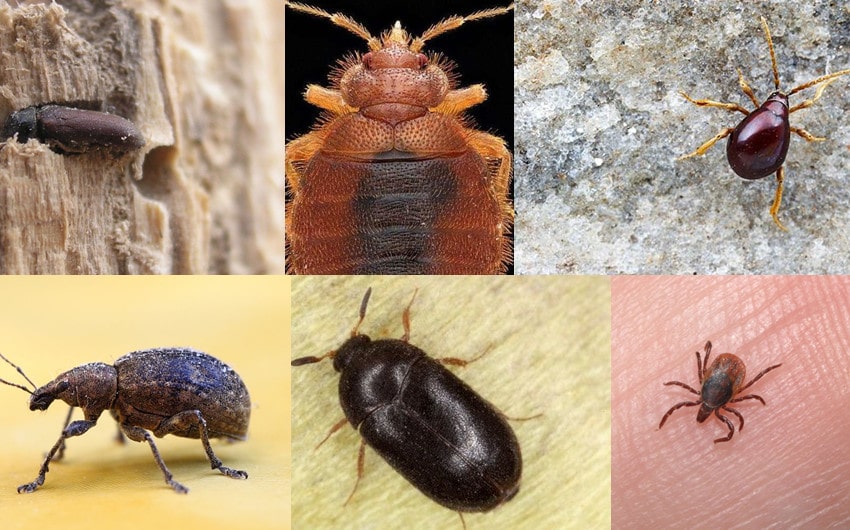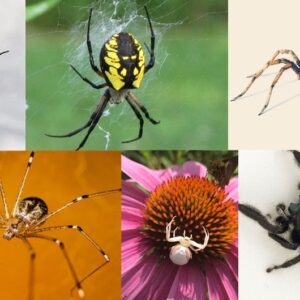
You might often have come across these creepy crawlies inside your home. Of all the bugs that bug you, the tiny black bugs might be the most common. You might be thinking, are they dangerous? How do you get rid of them? How do you prevent them from infesting your home?
After all, hardly anyone prefers having bugs as pets. Let’s go over everything you need to know about the tiny black bugs and how you can get rid of them as well as prevent further infestation.
What Are Tiny Black Bugs?
Not all the tiny black bugs you see are bed bugs or fleas, although they are more common and easily recognizable. There are many species of tiny bugs that are black. Here’s a list of possible species of black bugs you might come across.
#1. Bat Bugs

Image source: Pinterest
Bat bugs are very similar in appearance to bed bugs and are thus commonly mistaken for the latter. Although bed bugs have longer hair than bat bugs, you might find it difficult to differentiate between the two with the naked eye. But there are other factors that separate these two species.
Bed bugs feed on human blood, so these bugs prefer to stay closer to humans. You might find them hidden under your mattresses, in crevices in your furniture, etc. Bat bugs, as the name suggests, feed on bats’ blood. Naturally, they tend to remain closer to their hosts.
If you find black bugs on walls and ceilings, they are likely bat bugs and not bed bugs. Also, if you have a bat problem around your home, they are, again, most likely bat bugs.
#2. Carpet Beetles

Image source: Pinterest
Carpet beetles are also another species of black bugs you might find commonly in your home. Carpet beetle larvae are brown or black and covered with thick hair. The larvae of this species are known to bury into fabrics like silk, cotton, leather, and wool. They also irritate human skin. If you find tiny black bugs crawling over your bed, clothes, carpets, couches, and upholstered furniture, there’s a good chance that carpet beetles have infested your home.
#3. Spider Beetles

Image source: Pinterest
You can identify spider beetles pretty easily as they resemble spiders. These bugs have a round body with an outer shell. If you find black bugs in your kitchen or cupboards where you store food, they are likely to be spider beetles. Although spider beetles are relatively less harmful, they might be a nuisance if your home is infested with them.
#4. Ticks

Image source: Pinterest
Ticks are black and have an ovoid body. Ticks most commonly infest places that have tall grass and shrubs. They can also infect your pets. Ticks are dangerous as they can transmit many infectious diseases. One of these diseases is Lyme disease. If you live in an area that is infested with ticks, you will have to be cautious about tick bites.
#5. Fleas

Image source: Pinterest
Similar to ticks, fleas too can be dangerous. They bite dogs, cats, and humans as well. If you find black pepper-like spots on your pet’s fur, it is most likely to be fleas. Flea larvae hide well in crevices, beneath your furniture, carpets, and untouched spaces. If not identified early, a flea infestation can turn into a disaster.
#6. Woodworms

Image source: Pinterest
If your wooden furniture is damaged and you can find blurred holes in them, your home is most likely infested with woodworms. You will also find dust that almost looks like wood shavings over the damaged furniture. Woodworms can be black, brown, or slightly reddish. You may even find dead woodworms lying over or around the damaged wooden furniture.
#7. Fruit Flies

Image source: Pinterest
Fruit flies are attracted to, well, fruits. They are also drawn to organic waste you might have kept aside, including ripe fruits or even the fruits that have been kept for too long. They also love fermented products like yeast, beer, and wine. Be sure to look for fruit flies in your home if you have not emptied your garbage cans in a while.
#8. Larder Beetles

Image source: Pinterest
Larder beetles are oval-shaped, black insects that aren’t exactly dangerous but it’s unsanitary to have them around. They fly in through open windows and doors and make a home in almost any place possible. You can find them in stored food, on old books, or inside any insulation material.
#9. Weevils

Image source: Pinterest
Just like spider beetles, weevils infest your kitchen. They feed on rice, cornflour, seeds, nuts, and other food. There are different varieties of weevils like rice weevils, granary weevils, and maize weevils. If found in large numbers, they can cause a lot of damage to your stored food.
#10. Fungus Gnats

Image source: Pinterest
If you love gardening, you may find fungus gnats in your potted plants or manure. These flies chew on soil, roots, and other organic material found near plants. You can also find them on your indoor plants. They look similar to mosquitoes and do not fly around much.
Where Can You Find Tiny Black Bugs?
You can find tiny black bugs almost anywhere in your home. Here is a list of places you can look to check for bug infestation.
#1. In The Kitchen
Spider beetles and weevils are the most common tiny black bugs found in kitchens. They are found anywhere food is stored. Cupboards, kitchens, restaurants, grocery stores, etc. If your kitchen is infested, these bugs can eat up a lot of food, grains, and dry fruits, and even spices. Fruit flies are found near filled garbage bins containing rotting fruits and other fermenting substances.
#2. In Your Bedrooms
Carpet beetles, bed bugs, ticks, and fleas are the most common black bugs found in your bedrooms, over your bed linen, and on blankets. Carpet beetles can also be found on carpets that you have rolled out on your house floor.
#3. Outdoors
Ticks are mostly found outdoors in your yard or garden space where there is tall grass and shrubs. Bat bugs can also be found outside your home if there is a bat problem in the vicinity. Fungus gnats can also infest your potted plants, organic fertilizer, and other mixed composition.
#4. Near Your Windows
Most of these tiny black bugs come flying in through open windows and doors. Woodworms can infest your window frames if they are made out of wood. Many of these bugs can also make their home in and around the windows.
#5. Furniture
You can find woodworms in your wooden furniture and carpet beetles in your upholstered furniture. Carpet beetles eat into almost every commonly used fabric.
Why Do You Have Tiny Black Bugs?
There can be many reasons why you have a bug infestation.
#1. If You Own Pets
Ticks and fleas love animal fur. If you own a pet and you are living in an area susceptible to pest infestations, they can easily invade your home as well. If you do not own a pet and your home still has a tick infestation, you might want to check for any rodent infestation inside your home.
#2. If You Haven’t Been Careful Enough
Bed bugs can enter your house in many ways. For example, you can pick up bed bugs from your night out at a hotel or a bus ride back home. Also, if you have picked out furniture without checking for bug infestation, that too can turn into a major problem.
#3. If Your Surroundings Are Damp
Most tiny bugs make their home in protected spaces that are damp. Dampness is a conducive factor to their survival and reproduction.
#4. If Your House Has Been Vacant for Long
If your house has been empty for too long, it is natural to find a bug and insect infestation due to a lack of hygiene and maintenance.
#5. If You Have a Large Amount of Stored Food
Bugs like spider beetles and weevils are attracted to a large amount of stored food that you have not used for quite a while.
#6. If You Have Not Emptied Your Garbage Bins
Fruit flies get attracted to your garbage bins that have decaying organic food in them. If you do not regularly empty your garbage bins, you will surely find fruit flies swarming around.
What Harm Can Tiny Black Bugs Do?

Image source: Pinterest
#1. Bites
Bed bug bites can be painful. The affected area will appear red and swollen. Ticks prefer to bite warm parts of the body. Gradually, they will migrate to your armpits and groin. Tick bites can at most times be symptomless. However, if you are allergic to tick bites, it can cause rashes, burning sensations, pain, swelling, and blisters at the site of the bite. If the allergy is severe, it can even cause breathing difficulty. Flea bites are also highly painful.
#2. Itching
Bug bites can cause itching along with the other above-mentioned symptoms. Scratching the affected area can cause it to bleed and eventually get infected. Infected blisters will have white-topped surfaces.
#3. Infectious Diseases
There are many infectious diseases that are transmitted by ticks, fleas, and many other commonly found bugs. Ticks can cause a number of infectious diseases like Lyme disease, Rocky Mountain Spotted Fever, and Anaplasmosis. Some diseases resulting from fleas are Bubonic plague and Tularemia, among others.
#4. Damage To Furniture
If your furniture is made out of wood, woodworms can easily bore into it and create several tiny holes in the furniture. These holes are referred to as exit holes. You can also find carved-out tunnels in your furniture along with frass dust. Woodworms weaken your furniture or might even cause it to crumble.
#5. Damage To Fabrics
Black bugs like carpet beetles, spider beetles, and bat bugs can damage your fabrics by chewing on them. If you find holes and tears in your clothing, curtains, bed linen, carpets, or upholstered furniture, it is most probably caused by a bug infestation.
#6. Damage To Food
If you have stored food in your cupboards or kitchen, bugs like spider beetles can eat them up. The more the food is left untouched, the higher is the chance of an infestation. These bugs will eat almost anything — dry fruits, grains, cereals, etc.
What Can You Do to Get Rid of Them?
There are many ways to get rid of tiny black bugs. You can try getting rid of them on your own. If that does not work, you might need professional help.
#1. Clean Your House
The first step would be to thoroughly clean your house. Check your kitchen cabinets, closets, furniture, clothing, and bed linen for any signs of bug infestation. If your furniture is damaged, clean out all bug debris and frass dust. Wipe all of your furniture with your regular cleaning supplies. Be sure to remove all cobwebs too.
If you find any tiny black bugs in your food, discard all of the items that seem to be infested. Wash all your clothes, cushions, curtains, and bed linen thoroughly. Move all of your furniture aside and clear out the damp spaces. You should also cover up the cracks and crevices you find.
#2. Use Insecticides
It is best to take the help of a professional exterminator, especially if you have kids at home. If your home is infested with woodworms, you can apply a Permethrin-based spray or dip. This acts as a surface treatment. Along with the surface treatment, you should also reach deep into the tunnels and apply woodworm treatment paste, gel, or a spray.
This will prevent further infestation not only by woodworms but also other species of wood-eating bugs. If you have a flea infestation, use a flea spray directly onto them. Fleas tend to cluster, so a direct flea spray will kill them all.
#3. Get Your Pets Treated
If you have pets at home, they are susceptible to becoming flea or tick carriers. If your pet is infected, take it to a vet immediately and get it treated. The longer you ignore a bug infestation, the bigger the problem you’ll have to deal with.
How To Prevent Them?
Here’s a list of things you can do to prevent bug infestation.
#1. Keep Your House Clean
Keeping your house clean at all times prevents bugs from entering the house. Be sure to vacuum your floor, wash your clothes regularly, and fill up any cracks or crevices you find in the house. To prevent a food bug infestation, make sure that all your food is stored in airtight containers. Also, remember to empty your garbage bins regularly. If you aren’t using some of your clothes, keep them in airtight bags.
#2. Dry Up Any Damp Spaces Around
Damp spaces are the perfect environment for bugs to survive and breed. Look for any leaking pipes, drains, or faucets, and be sure to fix them immediately. Check your basement and attic regularly for any dampness. If there are places that are too damp, use a dehumidifier to dry them up. It also helps to use air-conditioners and dryers.
#3. Groom Your Pets Regularly
Make sure you take your pets to the groomers regularly. This will help prevent them from being infected by ticks or fleas. Look out for any signs of bug infestation like increased scratching and get them treated immediately.
#4. Keep Your Windows and Doors Closed
Most of these bugs enter through open windows and doors. Keep all of them shut when you can. It also helps to cover your home windows with meshes.
A Few Parting Words
Not all tiny black bugs you see are dangerous. Centipedes are one of the beneficial bugs you can find at home as they get rid of other insects like cockroaches, silverfish, termites, and moths. However, it might also be considered unsanitary to have bugs flying around in your home. Bug infestations can be a major nuisance, but if you take the necessary precautions, you can easily prevent them from entering your home.


